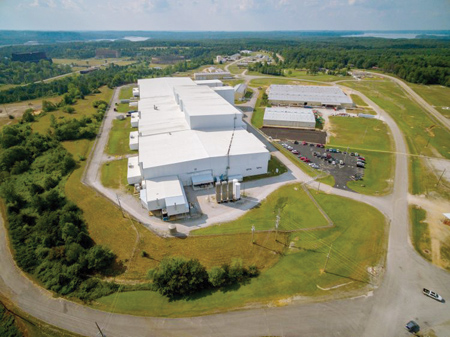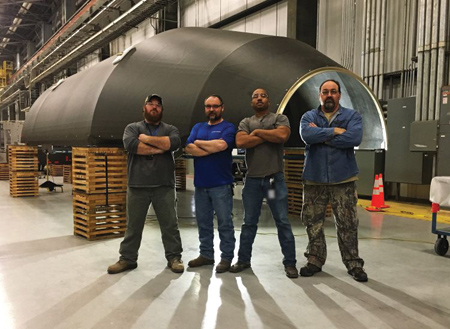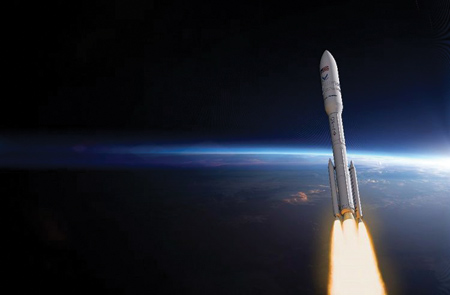
Northrop Grumman's Iuka, MS, facility employs more than 170 engineers, technicians and other personnel.

Iuka employees take pride in over a 20-year legacy of producing large composite launch vehicle structures.

Northrop Grumman's Iuka, MS, facility produced the first Antares fairing in August 2017.

OmegA will be Northrop Grumman's first heavy-lift rocket, adding to the company's current lineup of small- and medium-class vehicles.
In a small Mississippi town, a group of scientists and engineers recently gathered to discuss their next project: building large aerospace composite structures for Northrop Grumman's new OmegA rocket. OmegA is being designed to launch the U.S. Air Force's most critical spacecraft for U.S. national security missions.
The kick-off meeting took place in Iuka, MS, home to Northrop Grumman's large-scale composite rocket structure manufacturing facility where the company is building components up to 18' in diameter for the rocket. These include the nose cone, connecting sections between the rocket stages and other large composite structures for OmegA.
"Utilizing our expert team and innovative, flight-proven technology, our Iuka facility has over 20 years of experience manufacturing large launch vehicle structures," said Wendy Williams, Vice President, Aerospace Structures, Northrop Grumman. "We are excited to build on that heritage with the addition of OmegA composite structures to our product line here in Mississippi."
The Iuka facility has a rich 20-year history of manufacturing composite rocket structures for Northrop Grumman's Antares and Pegasus rockets, as well as United Launch Alliance's Delta IV and Atlas V vehicles. Iuka employees have manufactured more than 630 structures, including 432 that have successfully flown to space. The remaining structures are scheduled for upcoming Atlas V, Delta IV and Antares launches.
"Composite structures are extremely important in rockets and are the unsung heroes to the space industry," said a company spokesperson. "This innovative technology provides components that are strong enough to withstand the Max-Q dynamic forces during a launch as the vehicle fights against the physics of gravity and aerodynamic loads that happen as the rocket is leaving the Earth's atmosphere, all while weighing considerably less than their metal counterparts."
When launching a rocket, the total weight of the launch vehicle significantly impacts how much the rocket can carry into space. The lighter the rocket, the more performance capability it has to carry critical payloads into space.
Northrop Grumman is building OmegA in partnership with the U.S. Air Force through a shared cost program that enables the government to gain the best value in a new rocket. The team building OmegA includes rocket scientists, engineers and technicians who, on average, develop a new rocket every year. With more than 770 launches in the company's profile-including space and satellite launches, targets, interceptors, hypersonic and suborbital rockets-this team is a proven resource for the Department of Defense.
"For many, designing and building complex rockets is a once-in-a-career activity," said Rich Straka, Vice President, Launch Vehicles, Northrop Grumman. "For our team and our customers, it is what we do all the time."
This rocket is being produced completely on American soil. The program is based out of Northrop Grumman's Chandler, AZ, facility, where the company manufactures the rocket's thermal protection, flight systems and avionics. Northrop Grumman builds the first and second stage motors in Promontory, UT, and the strap on boosters in Magna, UT. The cryostage manufacturing is taking place in Michoud, LA, and Aerojet Rocketdyne's West Palm, FL, facility supplies the upper-stage RL-10 engine. OmegA's launch operations will take place from Kennedy Space Center in Florida, and Vandenberg Air Force Base in California.
The OmegA team is currently preparing for a ground test of the first stage motor this spring, followed by a ground test of the second stage in the fall. The rocket's first mission remains on track for launch in 2021.
For more information contact:
Northrop Grumman Corporation
2980 Fairview Park Drive
Falls Church, VA 22042-4511
703-280-2900
www.northropgrumman.com